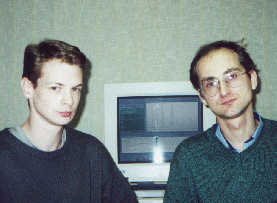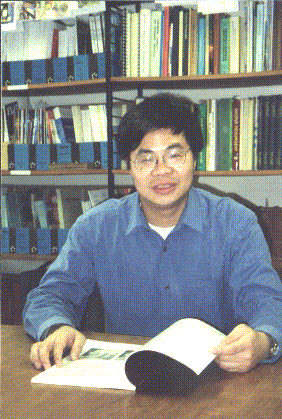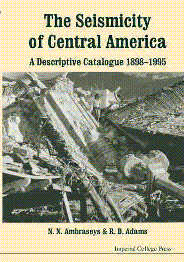Big Catalogue for a quiescent year
Even in comparison with its relatively quiet predecessor,
1998 lacked great earthquakes and prolific aftershock
sequences that can be especially challenging to sort out.
Nevertheless, continuing improvement in collecting data
resulted in more than 98% as many events as 1995, which is
the ISC's busiest year to date.
With few great earthquakes of late and more small events,
the average number of readings associated with each event is
falling, from 23 per event in 1995 and 1996, to 21 in 1997,
and 18 in 1998. This still exceeds the 16 readings per
event of 1993, when the Bulletin included many small
Japanese quakes.
Wider use of thresholds
The continued growth in the number of events in the
Bulletin results from desirable improvements in monitoring
and data exchange. But it also threatens the accuracy of
analysis by ISC seismologists, who must review an inexorably
larger set of data each year.
Implicit thresholding has taken place for many years, as
national agencies exclude small events from contributions to
the ISC. An explicit threshold was first used at the ISC
when events of 1994 were analysed. From then on, shallow
m<3.5 earthquakes reported by the JMA are excluded from the
Bulletin.
For earthquakes of 1998, the ISC excluded small events
from more contributors, including Bergen, Helsinki, and
Jakarta. The full set of criteria is posted at
http://www.gxjydl.com/doc/misc/1998thresholds.html
Use of thresholds frees the ISC to encourage contribution of
complete Bulletins, allowing the Centre to compile a more
comprehensive database of global seismicity. At the same
time, it helps ISC seismologists to focus on the events
where re-analysis has the most benefit.
|
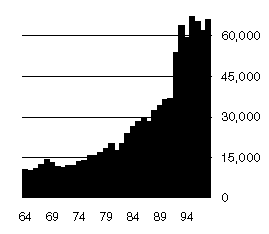
ISC data comprise about 65,000 events annually since 1993,
and more than 985,000 in total since 1964.
|
New data contributions
In recent years ISC has received data of the Philippine
Institute of Volcanology and Seismology only through NEIC.
PHIVOLCS resumed reporting both station readings and
hypocentre solutions directly to the ISC from 1998. The
hypocentres were introduced to the Bulletin from September
1998, which immediately improved completeness of the ISC
Bulletin in the area and cut the number of new events
"found" by the ISC from unassociated readings.
Also in the year, New Delhi and Pretoria replaced their
printed contributions with electronic versions, while JMA
added fault plane solutions to its electronic contributions.
In each case, the ISC had previously keyed only selected
data, and is now able to re-publish more.
|
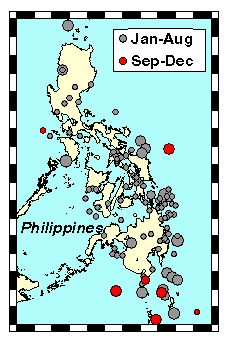
The 1998 Bulletin includes 111 events near Philippines
without a PHIVOLCS hypocentre; only 7, all in the periphery,
are from the last 4 months.
|
Catching up continues
Progress continued in correcting the publication delay
that accumulated during 1997-1998. Thanks to a fully
staffed team of three experienced editors, as well as
several changes in processing, it took only 9 months to edit
this year's Bulletin. Dmitry Storchak, ISC's senior
seismologist, is confident of catching up analysis to the
schedule during 2001.
|
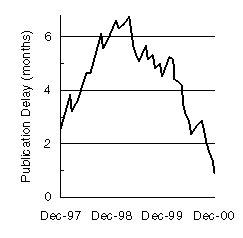
|
New association algorithm pays off
A new association algorithm was implemented from April
that takes more account of the likelihood that a station
will report readings for small, distant events. The new
algorithm also adds consideration of later phase times and
inconsistency between event magnitudes and phase
amplitudes.
In the past editors usually needed to manually
re-associate readings for 30% or more of the events each
month. Since implementing the new algorithm, automatic
association has erred on only about two-thirds as many
events.
|
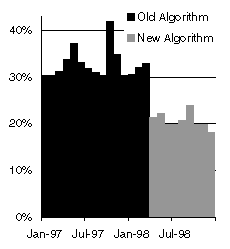
Fraction of events with association manually changed during
editing.
|
